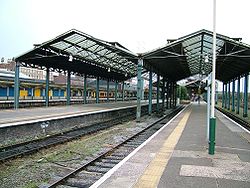
Chester General rail crash
Encyclopedia

Chester railway station
Chester railway station is a railway station in Newtown in the city of Chester, England. It is currently operated by Arriva Trains Wales, although Merseyrail, Northern Rail and Virgin Trains also run services from the station. It is situated to the north-east of the city centre...
(traditionally known as Chester General station) in northwest England
England
England is a country that is part of the United Kingdom. It shares land borders with Scotland to the north and Wales to the west; the Irish Sea is to the north west, the Celtic Sea to the south west, with the North Sea to the east and the English Channel to the south separating it from continental...
.
Course of events
The 19:31 freight train from Ellesmere PortEllesmere Port
Ellesmere Port is a large industrial town and port in the unitary authority of Cheshire West and Chester and the ceremonial county of Cheshire, England. It is situated on the south border of the Wirral Peninsula on the banks of the Manchester Ship Canal, which in turn gives access to the River...
to Mold
Mold, Flintshire
Mold is a town in Flintshire, North Wales, on the River Alyn. It is the administrative seat of Flintshire County Council, and was also the county town of Clwyd from 1974 to 1996...
Junction consisted of 38 wagons hauled by a Class 24
British Rail Class 24
The British Rail Class 24 diesel locomotives, also known as the Sulzer Type 2, were built from 1958 to 1961. One hundred and fifty-one of these locomotives were built at Derby, Crewe and Darlington, the first twenty of them as part of the British Rail 1955 Modernisation Plan. This class was used as...
diesel locomotive no. 5028. The first five wagons were tank wagons containing kerosene
Kerosene
Kerosene, sometimes spelled kerosine in scientific and industrial usage, also known as paraffin or paraffin oil in the United Kingdom, Hong Kong, Ireland and South Africa, is a combustible hydrocarbon liquid. The name is derived from Greek keros...
, petrol and gas oil.
At around 20:50 the train was approaching Chester on a 1 in 100 falling gradient
Gradient
In vector calculus, the gradient of a scalar field is a vector field that points in the direction of the greatest rate of increase of the scalar field, and whose magnitude is the greatest rate of change....
when the driver discovered that the brakes had failed. It ran past a signal at danger and through a set of points which were set for no. 11 bay platform
Bay platform
Bay platform is a railway-related term commonly used in the UK and Australia to describe a dead-end platform at a railway station that has through lines...
, where an empty diesel multiple unit
Diesel multiple unit
A diesel multiple unit or DMU is a multiple unit train consisting of multiple carriages powered by one or more on-board diesel engines. They may also be referred to as a railcar or railmotor, depending on country.-Design:...
was standing.
As there was nothing more he could do, the driver jumped out onto the platform with the train still travelling at around 20 mph. It ploughed straight into the DMU and completely destroyed the first coach. The second coach was torn from its bogie
Bogie
A bogie is a wheeled wagon or trolley. In mechanics terms, a bogie is a chassis or framework carrying wheels, attached to a vehicle. It can be fixed in place, as on a cargo truck, mounted on a swivel, as on a railway carriage/car or locomotive, or sprung as in the suspension of a caterpillar...
s and thrown up onto the platform where it demolished the refreshment room wall. Fortunately there were very few people on that part of the station, although the staff in the refreshment room had to shelter themselves from falling masonry
Masonry
Masonry is the building of structures from individual units laid in and bound together by mortar; the term masonry can also refer to the units themselves. The common materials of masonry construction are brick, stone, marble, granite, travertine, limestone; concrete block, glass block, stucco, and...
.
A major fire broke out when the burst fuel tanks of the trains ignited, but fortunately the fire brigade were based nearby and arrived within a couple of minutes. They were able to rescue a trapped postal worker and evacuated several passengers from an adjacent (fortunately lightly loaded) train before it too was engulfed by the fire.
Damage caused to the trains was severe, especially after petrol from two of the tank wagons began to boil and was forced out of the pressure relief valves, whereupon it ignited. The fire was not extinguished until 00:20 the following day.
The trains involved were all written off and a section of the station roof was damaged and consequently removed.
Causes
The first eight wagons were equipped with the vacuum brakeVacuum brake
The vacuum brake is a braking system employed on trains and introduced in the mid-1860s. A variant, the automatic vacuum brake system, became almost universal in British train equipment and in those countries influenced by British practice. Vacuum brakes also enjoyed a brief period of adoption in...
but the pipes had not been connected up. The train had run from Ellesmere Port as an unbraked freight train and stopped at Helsby
Helsby
Helsby is a large village and civil parish in the unitary authority of Cheshire West and Chester and the ceremonial county of Cheshire, England. At the 2001 Census, Helsby had a population of 4,701.-Geography:...
, where it needed to reverse. The guard had forgotten to connect up the vacuum pipes when the locomotive coupled up to the opposite end of the train, so that extra brake power was available on the falling gradient into Chester. The driver had also omitted to carry out a brake test before departure.

